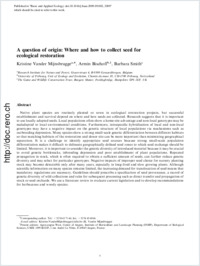A question of origin: Where and how to collect seed for ecological restoration
- Mijnsbrugge, Kristine Vander Research Institute for Nature and Forest, Geraardsbergen, Belgium
- Bischoff, Armin University of Fribourg, Unit of Ecology and Evolution, Switzerland
- Smith, Barbara The Game and Wildlife Conservation Trust, Burgate Manor, Fordingbridge, Hampshire, UK
-
14.11.2009
Published in:
- Basic and Applied Ecology. - 2010, vol. 11, no. 4, p. 300-311
English
Native plant species are routinely planted or sown in ecological restoration projects, but successful establishment and survival depend on where and how seeds are collected. Research suggests that it is important to use locally adapted seeds. Local populations often show a home-site advantage and non-local genotypes may be maladapted to local environmental conditions. Furthermore, intraspecific hybridisation of local and non-local genotypes may have a negative impact on the genetic structure of local populations via mechanisms such as outbreeding depression. Many species show a strong small-scale genetic differentiation between different habitats so that matching habitats of the restoration and donor site can be more important than minimizing geographical separation. It is a challenge to identify appropriate seed sources because strong small-scale population differentiation makes it difficult to delineate geographically defined seed zones to which seed exchange should be limited. Moreover, it is important to consider the genetic diversity of introduced material because it may be crucial to avoid genetic bottlenecks, inbreeding depression and poor establishment of plant populations. Repeated propagation in stock, which is often required to obtain a sufficient amount of seeds, can further reduce genetic diversity and may select for particular genotypes. Negative impacts of improper seed choice for nursery planting stock may become detectable only after many years, especially in long-lived and slow growing plants. Although scientific information on many species remains limited, the increasing demand for translocation of seed means that mandatory regulations are necessary. Guidelines should prescribe a specification of seed provenance, a record of genetic diversity of wild collections and rules for subsequent processing such as direct transfer and propagation of stock or seed orchards. We use a literature review to evaluate current legislation and to develop recommendations for herbaceous and woody species.
- Faculty
- Faculté des sciences et de médecine
- Department
- Département de Biologie
- Language
-
- English
- Classification
- Biological sciences
- License
-
License undefined
- Identifiers
-
- RERO DOC 17231
- DOI 10.1016/j.baae.2009.09.002
- Persistent URL
- https://folia.unifr.ch/unifr/documents/301505
Statistics
Document views: 194
File downloads:
- pdf: 691
